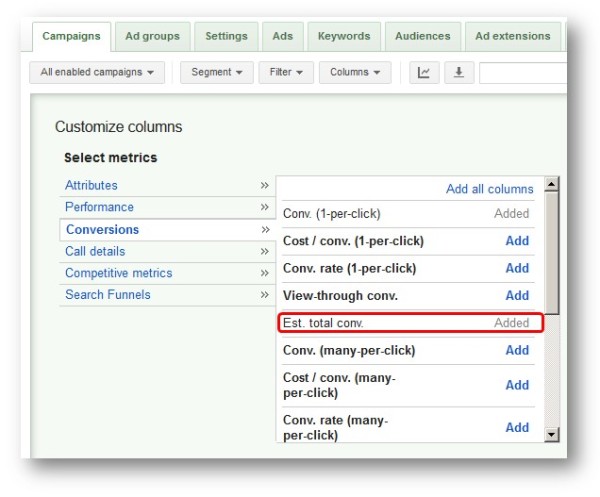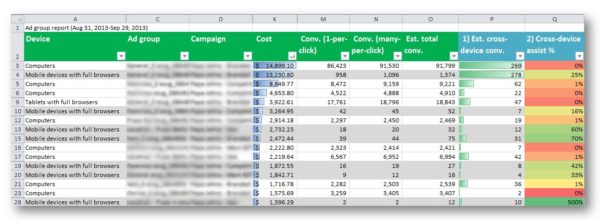The Future Of Online Analytics: New AdWords Estimated Cross-Device Conversions
A couple of months after the paid search world had to transition to AdWords Enhanced Campaigns in the name of simplified and more relevant cross-device ad management, we are finally getting some initial food for thought with regard to cross-device performance. I was calling it the “next frontier for online marketers” in a previous post, […]
A couple of months after the paid search world had to transition to AdWords Enhanced Campaigns in the name of simplified and more relevant cross-device ad management, we are finally getting some initial food for thought with regard to cross-device performance. I was calling it the “next frontier for online marketers” in a previous post, and we are now officially getting there!
A New “Estimated Total Conversion” Column Is Rolling Out
In AdWords, a new column called “Est. total conv.” was made available for some beta accounts recently. However, this column doesn’t seem to be available at the keyword level yet — only at the campaign and ad group levels.

The official field description is as follows: “This is our best estimate of the total number of conversions that AdWords drives for your business. What it means: Est. total conv. = Conv. column + Est. cross-device conv. column”

The description doesn’t say whether the “Conv. Column” field is referring to “Conv. (1-per-click)” or “Conv. (many-per-click).” However, I’d tend to think Google is using the “Conv. (many-per-click)” column for reference.
Also, Google plans to factor in other conversion types like phone calls and in-store visits in the future — not right now, though.
Leveraging The New “Estimated Total Conversion” Column
There are lots of different ways to look into this new column — let me just suggest two of them:
- Since the “Est. cross-device conv.” column is not provided, one can easily calculate it such as Est. cross-device conv. = Est. total conv. – Conv. (many-per-click). This is assuming Google is using the Conv. (many-per-click) column rather than Conv. (1-per-click).
- Analyzing a new ratio which could be called something like “Cross-device assist %” such as: Cross-device assist % = Est. total conv. / Conv. (many-per-click) – 1. The higher the ratio, the more cross-device conversions occurred as a percentage. A ratio of 0% means there were no additional cross-device conversions, while anything greater than 0% indicates some cross-device assists.
In the below paid search report by ad group and device, those rows with the highest cross-device assist % correspond to assists from mobile devices. That was expected; however, now we have some hard numbers.
Another way to look at it is strictly by device, such as in the below pivot table. I noticed a couple of odd things:
- The numbers in a report differ from the numbers from the AdWords interface by roughly 5-10%.
- The total number of estimated total conversion is lower than the total number of last-click conversions.
- Those additional conversions attributed to mobile devices are somehow subtracted from other devices. As a result, this advertiser’s true mobile CPA is 22% lower than it seems, looking at just the last-click, while the true desktop CPA is 5% higher and the true tablet CPA is 15% higher. You’ll definitely want to take this into consideration when adjusting your desktop/tablet bids, as well as your mobile bid modifiers.

Conclusion
With the new “Estimated total conversion” column, Google is attempting to tackle the increasingly complex issue of cross-device revenue attribution in paid search — and it is definitely a leap forward.
However, in order to make it fully trustworthy and actionable for online marketers, it’d be great to get more transparency from Google regarding the way the numbers are put together (with some kind of confidence interval?), then have the Est. total conv. column available at the keyword level for more granular insights — and ultimately across multiple channels for more sophisticated revenue attribution modeling.
Contributing authors are invited to create content for MarTech and are chosen for their expertise and contribution to the martech community. Our contributors work under the oversight of the editorial staff and contributions are checked for quality and relevance to our readers. MarTech is owned by Semrush. Contributor was not asked to make any direct or indirect mentions of Semrush. The opinions they express are their own.
Related stories
New on MarTech

